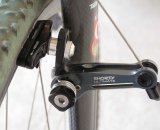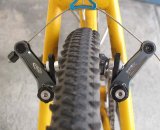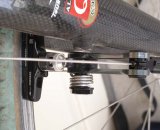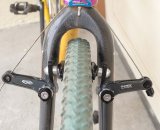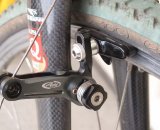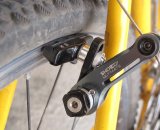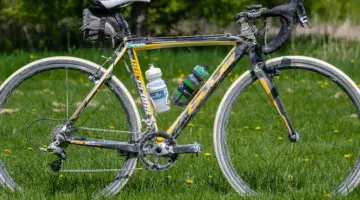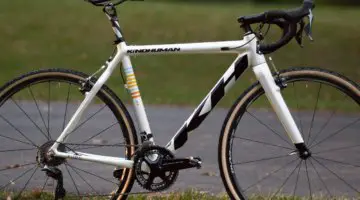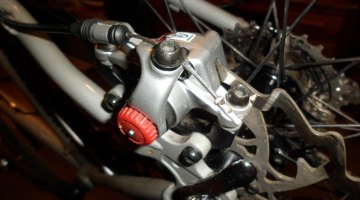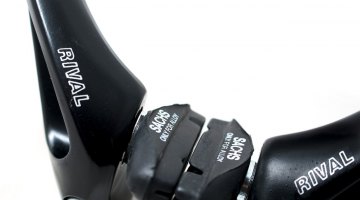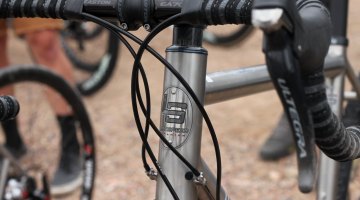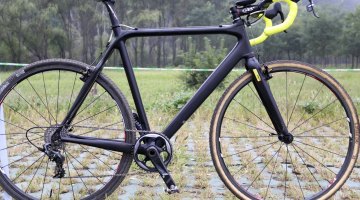by Clifford Lee
The Avid Shorty Ultimate cantilever brakes have been in development for several years, and we’ve been anxiously awaiting our chance for a review since we first learned they were coming. After prominent cyclocrossers, including US national champion Katie Compton and world champion Zdenek Stybar, relied on the Ultimate for speed-scrubbing duty last season, SRAM has refined its design and has the brakes in full production this season. After several weeks of intense use, we’ve got the most comprehensive review to date by our resident brake expert for all you gearheads drooling over a pair. For those of you who want to geek out even more and understand brake setup and see a lot more brake reviews, be sure to check out our authoritative articles on cantilever brakes in Cyclocross Magazine Issue 7 in print.
Why Cantilever Brakes?
The use of cantilever brakes in cyclocross is based on the practical need to have clearance for a wide tire and for debris in varying conditions. This need necessitated the absence of a brake arch connecting the two arms, instead having the two arms fit to fixtures that are part of the frame and fork. Many variations on this theme have resulted, including direct pull cantilevers, sometimes called V-brakes. Tradition makes cantilevers with a straddle cable the emotional choice, and the advantage of the traditional design is the flexibility to alter braking power and pad-to-rim clearance for muddy conditions.
Two basic designs of traditional cantilever brakes have evolved: wide profile brakes with high pad clearance based on the original French Mafac design; and narrow, low profile brakes based on designs made popular in the late 80s and early 90s on mountain bikes. Narrow profile designs attempted to wring more power out of the cantilever brake design by increasing the lever arm length and improving straddle cable mechanical advantage, while maintaining a reasonable profile for trail and heel clearance.
Avid Shorty Ultimate: Two Brakes in One?
Cyclocross racers typically have to chose between the two designs based on expected conditions and braking needs. The biggest quandary in cyclocross is balancing mud clearance with the need for heel clearance when dismounting the bike. Avid has addressed this with the new Avid Shorty Ultimate cantilever brake. It has the unique ability to have its configuration easily changed from wide to narrow. Their promise is appealing: Live in a dry area or descending some gnarly trails? Set them up in the low profile setting and enjoy more power. Traveling to Portland for a muddy Cross Crusade race? Change them to wide profile and enjoy mud clearance.
Interestingly, we received a set with one set up as low profile and the other as wide profile, one with the straddle release on the left and the other with the straddle release on the right. Set up as wide profile front and low profile rear, this put the straddle releases both on the left side of the bike. Though the boxes are labeled front and rear, they could be labeled right or left release since the profile can be changed. (The arms are not reversible, however, since they cannot be flipped around on the bushing)
The brake arms themselves are beautifully finished with a nice anodization, and they pivot via a bushing that sits directly on the brake post. The Avid Shorty Ultimate cantilever brake uses road style brake shoes with cartridge pads. The shoes, or cartridge holders, are not typical, as they use a female end on the cartridge side mated to a finished 4mm screw with spherical washers for pad alignment. Included are nice black compound pads made by Swisstop.
There’s a barrel adjuster for the straddle cable on the loose end, allowing the adjuster to be used as a small handle for cable release – a smart and nice touch for opening the brakes up quickly with gloved hands. When hooking the straddle back to the arm, attention has to be paid to seat the square post in the hole, no more than an eighth turn in any direction, and actually the easiest I’ve ever used! Another smart feature is the use of a 3mm and 4mm hex fitting on opposite sides of the straddle anchor screw – no more searching for two 2.5mm Allen keys.
Narrow or wide profile?
The advantage of wide profile designs is the clearance of the pad at the rim for mud clearance, but at the expense of braking power. Low profile designs offer more power at the expense of pad-to-rim clearance. If we consider the geometry of the two designs, basic physics yields the difference in performance due to both brake arm leverage and straddle cable geometry. The typical low profile brake has a pivot to cable anchor distance of approximately 70mm, whereas a typical wide profile brake is 25mm shorter at around 45mm (see Issue 7 for measurements and reviews of nearly a dozen brakes). The longer lever arm of the low profile design gives more mechanical advantage, but requires more cable pull to achieve that. Other factors that affect all of this are the angle between the straddle cable and brake arm, the distance between the pad and the pivot, and the straddle cable length.
Typical wide profile brakes have a pad face to cable anchor angle (subtended at the pivot) of 110 to 120 degrees, and this brake falls within this range. In comparison, that angle for low profile brakes, including these, is typically 60 to 70 degrees. This all depends slightly on pad spacing and position.
The Avid Shorty Ultimate cantilever brakes use the same arm in different configurations, so the pivot to cable anchor length doesn’t change. Any change in braking power comes only from the angle of the arms and the straddle angle and length. As a compromise, the arm length is 55mm, 10 to 15mm wider than a typical wide profile and 15mm shorter than a typical narrow profile cantilever brake. Hence, the power of the low profile configuration is less than typical for this brake style, and more powerful than a typical wide profile. This is an important point if you’re considering upgrading to these brakes with the hope of gaining more stopping power. Geometry and physics suggest that if you’re already running a low profile brake, you’ll be unsatisfied. But wide-profile brake users tired of a death squeeze just to slow down should gain some stopping power – especially if the Ultimate is set up in low profile configuration – but not quite as much as switching to a typical low-profile brake would yield.
In wide profile configuration, the arms protrude quite a bit and pad-to-rim clearance is a little less than normal due to the longer brake arm. Avid claims there is a 20 percent increase in power when set up in the narrow versus the wide profile. Recall from our comprehensive article on cantilever brake setup in Issue 7 that, for a given brake, power is largely controlled by the angle of the straddle cable. In general, if the two ends of the straddle cable are straight (almost parallel) to the main cable, you’re getting less leverage and more travel, opposite is true for a wide but low straddle. Normally the power difference between a wide profile and low profile cantilever brake is probably closer to 40 percent, but on the Avid Shorty Ultimates, it’s only about 20 percent because the arm length remains the same between configurations.
The Ultimate Easy Setup?
These brakes set up very easily due to the well-designed pad holders with the spherical washers and the easily adjustable spring tension. The brake arms fit close to the frame over the bosses, inboard to the springs, so there’s less leverage from the brake bosses themselves, and theoretically less flex. The downside? This puts the pads further in towards the frame or fork and may create a clearance issue during a wheel change since the pads won’t clear the frame, which limits how far the brake opens. This was not a problem on my steel frame with an Alpha Q CX fork, but may pose a problem with other frame or fork combinations.
The Avid Shorty Ultimate feel smooth at the lever, aided by the ability to dial in return spring tension and the excellent finish of the pivot bushings. Once the pads contacts the rim, the feeling is firm, as the short brake arms and short pad are stiff and don’t quite have the mechanical advantage to cause the pad deformation that typically results in a squishy feel at the lever.
Out riding, the pad and brake combination is a great speed modulator, but decent hand strength is required for stop-on-a-dime stopping power, even in dry conditions. For stronger braking, you could try changing the stock SwisStop black pads to the new SwisStop green, KoolStop Salmon or Dura Ace 7900 for an aluminum rim. Certainly, as SRAM/Avid indicates, the narrow profile setup offered more stopping power, due to the change in the cantilever angle, the straddle cable angle, and the shorter straddle cable. Whether in narrow or wide configuration, these brakes outperform other (shorter) wide profile cantilevers, but have notably less stopping power than the best narrow profile cantilever brakes.
Conclusion:
There’s a lot to like with the Avid Shorty Ultimate – they’re beautiful cantilever brakes with nice fittings, adjustments and a smart, flexible design. I think the changeable configuration is perhaps more appealing on paper than in practice, however, since the amount of pad clearance and power gains by changing the configuration isn’t much, and they’re really quite long to use in wide profile configuration in the back – there’s a decent risk you may kick them with your feet during mounts and dismounts. I’d most likely set them and forget them, using the low-profile setting for both brakes. They’re not the lightest or the cheapest option, but the adjustability and finish are top-notch.
There’s two ways to think about these brakes. If you’re a glass half-full guy, they’re low-profile brakes with a little extra pad clearance or a wide profile design with a bit of extra power. Or if you’re a glass half-empty guy, they’re less powerful than most low-profile brakes and have less clearance than most wide profile brakes. And if you’re indecisive? They just might be the perfect choice. The bottom line? If you’re not out to maximize power or clearance but need a balance of the two and want a finely finished, easily set-up brake, Avid has the ultimate cantilever brake for you.
Product Details:
- Avid Shorty Ultimate, MSRP $98 per wheel
- 77g per wheel with hardware, no shoes/pads; 115 g with proprietary shoes and Swisstop pads
- Pivot to cable anchor: 55mm; Pivot to brake pad face: 40mm; Angle: 120 degrees in wide profile, 80 degrees in low profile (10 degrees wider than typical)
- Clearance: for 9mm of cable pull at the lever yields 3mm of pad clearance on each side in wide profile, 2.5mm+ in narrow profile
- Includes a nice 7 gram black aluminum alloy straddle hanger and a straddle cable
Photo Gallery:













